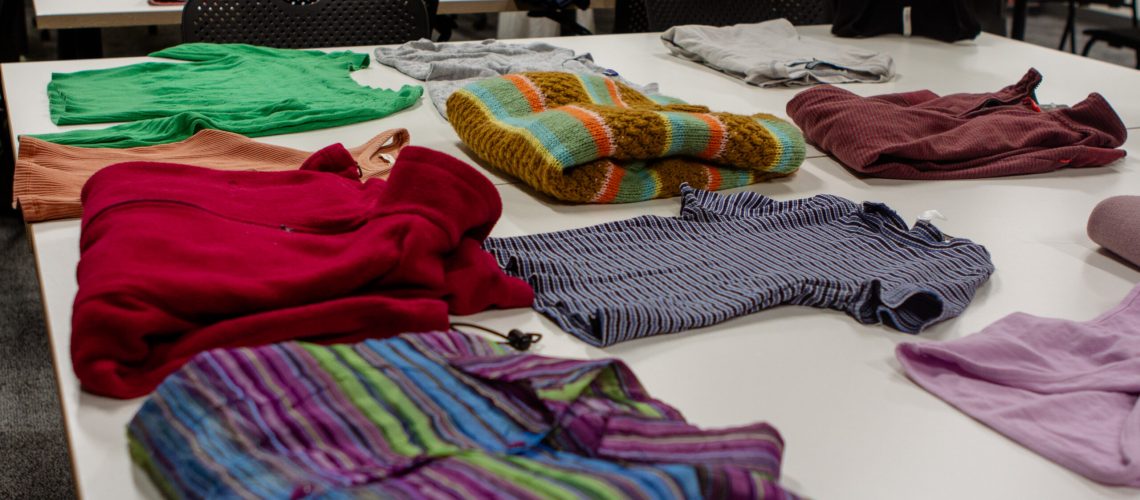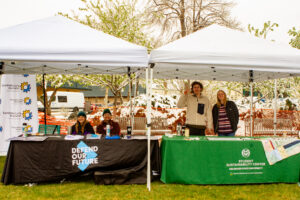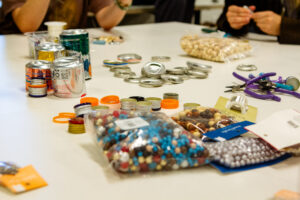Written by Kierra Vanevenhoven
In the relentless churn of global fashion, where trends rise and fall like fleeting whispers, there exists a shadowy underbelly hidden beneath the shimmer of runway lights and vibrant online advertisements. It’s a world where garments are born amidst the hum of machinery, stitched together by hands unseen, and swiftly dispatched to consumers around the globe. Yet, behind the facade of glamour lies a sobering reality: the journey of a garment doesn’t end with its purchase. Instead, it embarks on a silent journey, destined to eventually meet its demise in the vast wastelands of landfills. Each year, millions of tons of textile waste are discarded, their vibrant colors dulled by the harsh sun, their once-cherished fabrics slowly decomposing. An endless dance of buy, discard, repeat, and overconsumption echoes the fleeting nature of fashion itself.
Oftentimes, the allure of fashionable clothing overshadows the heavy burden of the industry, from environmental degradation to unethical labor practices. Yet, within the vibrant community of Fort Collins, Colorado, a quiet revolution is underway. Here, individuals and businesses like the Zero Waste Team and Patchwork Initiative at Colorado State University (CSU) and Create Good Co. are leading the charge in sustainable fashion. Through their innovative solutions and collective efforts, they are redefining the narrative, urging consumers to embrace a more mindful approach to shopping for clothes.
Fashion’s Hidden Costs
The late 20th century witnessed a transformative shift in the fashion industry with the emergence of fast fashion. Originating in the 1980s and gaining momentum in the following decades, fast fashion introduced a business model focused on rapid production, low prices, and frequent turnover of clothing collections.
Brands like SHEIN and Temu have since adopted this approach, capitalizing on the desire for trendy clothing at affordable prices by outsourcing production to countries with lower labor costs and swiftly adjusting their manufacturing processes to meet evolving trends. Dr. Ruoh-Nan ‘Terry’ Yan, a professor in the Department of Design and Merchandising at CSU and an expert in consumer behavior and sustainability practices, emphasizes the allure of fast fashion brands for consumers.
“On the supply side, we are seeing more fast fashion brands coming to the market, and customers respond very well to those products,” Dr. Yan says. “Why? Because of economic factors. [Products] are inexpensive and feed the consumer’s need for variety or wanting to have different styles every day without having to pay a lot of money.”
This rapid turnover of clothing significantly contributes to pollution, resource depletion, and textile waste. According to the Natural Resources Defense Council, the fashion industry is responsible for anywhere between four and 8.6% of global greenhouse gas emissions, more than the aviation industry itself. Additionally, the World Bank estimates that around 20% of global water pollution comes from the textile dyeing and treatment process alone.
“To start with fashion, you have to start with the textile material, including fibers, yarns, and fabrics and the processes of dyeing, finishing, and printing,” explains Dr. Yan ‘Vivian’ Li, a CSU Design and Merchandising Assistant Professor specializing in textile science and sustainability. “Historically, the textile industry has been unsustainable… significantly contributing to air, water, and environmental pollution.”
One example of this environmental toll is denim production, particularly the indigo dyeing process. Dr. Li highlights that denim production entails multiple finishing treatments, leading to substantial aerosol pollution. This pollution not only harms the environment but also jeopardizes the health of workers, who must wear masks to shield themselves from the fumes generated during the indigo dyeing process. Moreover, the widespread use of synthetic fibers, such as polyester, worsens the environmental impact of the fashion industry.
“Synthetic materials take a long time to decompose,” Dr. Li says. “Just like a plastic bottle or plastic bag, it may take 100 years or even longer to digest.”
However, as consumers increasingly recognize the negative impacts of unsustainable fashion practices, the demand for alternatives grows. This shift has fueled the rise of the sustainable fashion movement, advocating for ethically produced clothing with minimal environmental impact.
A Fashion Forward Campus
Amidst Colorado State University’s campus, a noticeable shift towards sustainability and environmental stewardship is underway. Various student-led groups lead this movement, aiming to reshape the campus and promote a culture of sustainability. Among these groups is the Zero Waste Team, a passionate collective of students driven by a shared commitment to positive environmental change.
The Zero Waste Team envisions a campus with minimal waste, preserved resources, and sustainable habits. Levi Vaughan, the team’s financial officer, emphasizes how they’re just one part of CSU’s vibrant sustainability community, all united in pursuing a greener future.
“It’s all about helping to take away those stereotypes and stigmas,” Vaughan says. “Reframing what [sustainability] looks like for people and helping everyone find their own niche in it.”
Throughout the semester, the campus buzzes with anticipation as students gather for the Zero Waste Team’s signature event—the clothing swap. Here, in a sea of fabric and color, students exchange old garments for new treasures. Swaps allow students to come together to share, recycle, and reinvent their wardrobes.
“I’ve gotten some awesome stuff from the swaps,” Vaughan says. “It’s a community and social mindset. You can bring whatever you don’t wear anymore and get whatever else you need.”
Moreover, the team offers monthly mending meetings where students have the chance to breathe new life into their worn-out belongings. Inspired by his grandmother—a skilled seamstress—Vaughan imparts his knowledge of hand sewing and embroidery to eager participants.
“Spicing up [your things] with embroidery keeps your own gear exciting without having to get new stuff,” Vaughan says. “It’s all about using what you have.”
For many students, mending meetings offer a canvas of creativity, a chance to resurrect treasured items from the brink of disposal. Each stitch tells a story, each repair a labor of love. Whether it’s a weathered backpack adorned with memories of adventures past, or a beloved pair of jeans worn thin from years of wear, these mending sessions are a sanctuary of self-expression, where students infuse their personal touch into every thread and patch.
Mending Fashion, Restoring Purpose
In addition to their direct outreach efforts, the Zero Waste Team collaborates with various campus organizations and local figures to advance their mission. From composting initiatives to educational workshops on fast fashion and waste reduction, the team’s collective impact extends far beyond the confines of the university.
Among these collaborations is the Patchwork Initiative, a student-led project fueled by a shared passion for promoting sustainability and reducing clothing consumption. The initiative hosts mending workshops and provides upcycling education for both students and community members. As part of this endeavor, the initiative also looks to small-scale, circular economics models for inspiration, guiding its approach to sustainability.
“Circular fashion is creating the longest life out of what you have. Mending it, upcycling it, doing whatever you can to repurpose it,” explains Patchwork Initiative Coordinator Sophie Richter. “Then once it’s reached the complete end of its life, finding a way to circle it back in. Whether that be giving it to a consignment store or finding a way to recycle it and turn those textiles back into something new.”
From the delicate dance of a colorful hand stitch to the intricate strokes of personalization embellishing an embroidered bag, The Patchwork Initiative offers guidance into a plethora of mending and upcycling techniques for anyone willing to learn.
“When I was younger my puppy chewed up the side of my backpack and then at one point, I took it on a camping trip and accidently dropped it into the fire,” Richter says laughing at the memory. “I ended up ripping open the seams of it and using a patch to close the hole… It was a big project that had so many memories behind it. It was so cool to restore it and keep using it.”
Through these acts of restoration and personalization, Richter and others like her weave a narrative with each stitch and repair—a tale of resilience, creativity, and the enduring connection between people and the clothes they wear.
“Through mending you create an emotional tie to that clothing piece. When you mend an item, you’re also creating a sense of pride in your clothing,” Richter explains. “So many people are so used to overconsuming, that they don’t have that same level of emotion toward their pieces.”
Sustainable Chic Beyond Campus: Create Good Co.
As you step through the door of Create Good Co., a kaleidoscope of colors and textures greets your senses. The air is alive with the gentle hum of the sewing machine behind the counter and the nostalgic tunes of throwback music. Racks decorated with patchwork masterpieces and plush quilted coats line the walls.
In Old Town Fort Collins, Create Good Co. offers an escape from the bustling streets with vibrant patterns, upcycled treasures, and unique finds, enveloping shoppers in a tranquil oasis away from the city’s noise.
In the heart of the store, amidst piles of fabric and spools of thread, is Maggie Naffziger—the visionary founder and owner of the Fort Collins store. Her warm smile greeted each customer as they stop in.
Create Good Co. traces its roots to the creation of the “boyfriend skirt,” crafted from repurposed men’s shirts by Naffziger herself. This invention ignited her passion for sustainable fashion, serving as both an artistic expression and the foundation of her business venture.
“Repurposing is kind of like solving a puzzle because you have to work in the confines of the garment that already exists,” Naffziger says. “I just fell in love with trying to figure out how to make something new from something that already existed.”
Create Good Co. started small in 2016, with Naffziger selling her creations at markets. It took six years to gather enough inventory for a store opening in 2022. Since then, Naffziger has focused on promoting sustainable fashion and educating consumers about conscious consumption. “Our main mission is to divert waste from landfills,” Naffziger explains.
Moreover, the process of finding pieces and crafting products for the brand involvesscouring thrift shops, vintage stores, and even yard sales to source materials. Each item is meticulously crafted by hand, with attention to detail and a focus on quality.
Naffziger’s journey of sustainable fashion began with her mother, a professional seamstress, who taught her the art of sewing at a young age. Drawing inspiration from her upbringing, she finds it fascinating to mix and match styles and rework patterns, adding unique touches to popular designs. Her creations often feature patchwork denim, with jackets, pants, and skirts adorned with scrap pieces, making each piece truly one of a kind.
For those who dare to dream of their own sustainable fashion venture, Naffziger offers simple advice: “Just go for it. What’s the worst that can happen? You keep trying until you get it… it’s a chance to reinvent [a clothing piece].”
The Future of Fashion
The future of fashion is increasingly intertwined with sustainability, driven by groups like the Patchwork Initiative, the CSU Zero Waste Team, and businesses like Create Good Co. These efforts pave the way for a more sustainable approach to clothing consumption, showcasing that adopting more sustainable habits such as mending or thrifting is attainable for anyone.
“If there’s something you’ve really been wanting, make it your goal to find it while thrifting,” Vaughan says. “It’s so much more fun to have a story about the [clothing you buy].”
Richter echoes this sentiment, emphasizing the importance of thrift stores in diverting clothing from landfills. “Probably 95% of my wardrobe is thrifted,” Richter shares. “I try to be really mindful about thrift stores I’m supporting… especially in our current society, people use thrift stores as dumping grounds to rid themselves of their own overconsumption which is just furthering the issue…make sure to support local thrift stores or consignment stores that are more mindful about their consumption and distribution habits.”
In addition to scoping out local thrift stores, learning how to mend and sew can be easy ways to practice sustainability. From patching up a well-loved pair of pants to transforming an old shirt into a trendy tote bag, the possibilities are endless. Through the art of mending and sewing, individuals can not only extend the lifespan of their clothing but also express their unique style.
“I hope [sustainable fashion] will evolve into people taking up those mending practices and sewing practices,” Richter says. “I think it’s something specifically that our generation is lacking…a lot of people have lost those skills and it’s important that we bring them back.”
If you’re interested in getting involved, follow the Patchwork Initiative on Instagram or email Sophia.Richter@colostate.edu, and follow the Zero Waste Team on Instagram. Additionally, Student Sustainability Center on Instagram and subscribe to the Green Bulletin email list to stay updated on the latest events.
To reach The Green Bulletin, contact the SSC Content Officer at samanthanordstrom1@gmail.com






